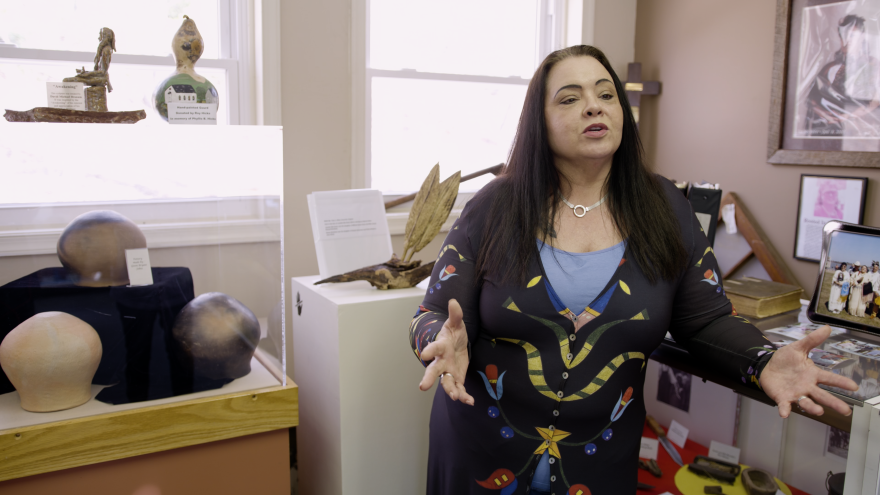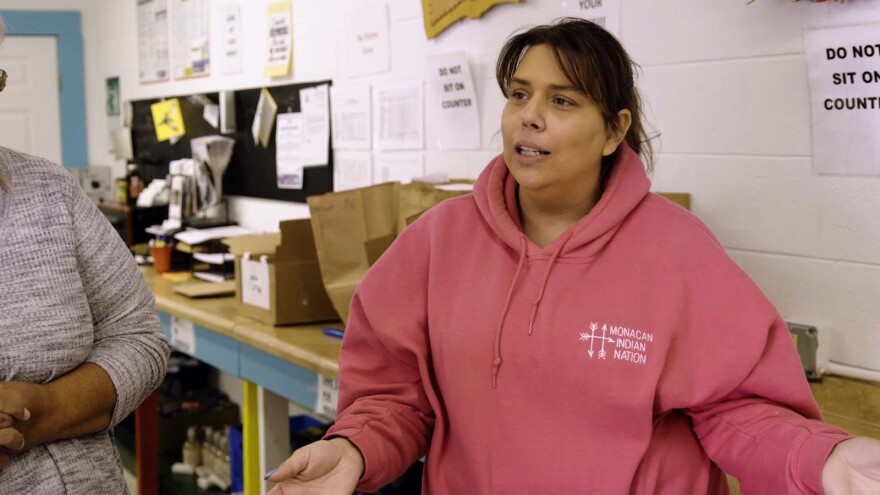Chief Kenneth Branham is proud to claim his Native American heritage, but he frequently encounters people who push back by saying, “You don’t look Indian.”
“We hear that a lot,” said Sally Latimer who, like Branham, traces her ancestry to Monacan forebears. She affirms that their appearance doesn’t fit the stereotype of Hollywood Indians. But despite long-lasting discrimination in their community and daunting obstacles on the path to federal recognition, the Monacan people have worked proudly to carry their tribal traditions forward.
“When you talk about your people — you got children, you got the middle-aged people, which I call the workers, and then you got the elders,” said Kenneth Branham. “And you need to take care of the elders because that’s history. The children are the future.”
Branham and Latimer are among the close-knit community of Monacan descendants centered in Amherst County, where their ancestors lived long before the area was settled by Europeans. “The Monacan people are an amazing story of survivance,” said Jeffrey Hantman, professor emeritus in the Department of Anthropology at the University of Virginia.
The presence of the Monacans dates back more than 10,000 years in the Mid-Atlantic region; their original territory covered more than half of present-day Virginia. Unlike the Algonquin-speaking people who were first encountered by English settlers in Jamestown, the Monacans were Siouan-speaking people whom scholars believe migrated east from the Ohio River Valley. Today the Monacan Indian Nation consists of about 2,600 members.
One of the caretakers of that history is Edith Branham, director of the Monacan Indian Nation Museum. The museum property includes an 1868 log schoolhouse where Monacan children were educated until they were allowed to attend public schools with whites in the 1960s. “This is the original school room here, the tiny little school room,” Edith Branham said while giving a tour. “My mom says that she can remember sometimes it’d be like 20 kids.”

“It’s an overwhelming feeling to know that my great-grandparents and my great-great-grandparents sat in this place,” said Latimer. “The feeling can’t be explained. It’s a connection to our ancestors.”
Both inside and out of the realm of education, prejudice against Native Americans was reinforced statewide in 1924 with passage of the Racial Integrity Act, a Virginia statute that sought to draw clear lines between white and non-white people. The law was the brainchild of Walter Plecker, a state official and white supremacist who challenged the Monacans’ claims of Indianlineage on their birth certificates.
Bertha Riley, a member of the Monacan Tribal Council, described bringing her birth certificate to a new job and having to explain why she was classified as “Negro.”
“We’re not talking about things that happened 100 years ago or 200 years ago,” added Latimer. “We’re talking about things that are still happening.”

But pride in their heritage persisted, and in the past decade the Monacans have worked alongside other Native American nations in Virginia to seek recognition from the federal government. After many stops and starts, in 2018 Congress passed the federal act recognizing six Native American communities as sovereign tribes in Virginia, including the Monacan Indian Nation.
“I didn’t need federal recognition for me, but I wanted it so my grandmother and my mom and dad could be proud of who they were — and instill this pride in our grandchildren,” said Kenneth Branham. “Nobody should be ashamed of who they were born.”
The tribe recently purchased 1,300 acres in Amherst County, with plans for a health clinic, senior center and other community infrastructure. While the facility will provide medical care and meeting space, some also see it as a catalyst for repairing the fabric of the community.
“I was raised literally by a village,” said Edith Branham. “Being able to eat at one grandma’s house and run across the street and eat dessert at the other’s in the same community was awesome.”
Now the community elders are energized by the prospect of new facilities and better services, smiling and greeting each other with hugs when they gather. “We’ve got them where we want them to be and they’re happy,” she added. “Now it’s time to focus on our youth.”
This article is based on the Monacan Indian Nation episode from the new VPM docu-series Life in the Heart Land. The series gets to the heart of those creating unique solutions to rural America’s toughest challenges.
Watch Thursdays at 8:30 p.m. on VPM PBS or anytime on the PBS App.
Visit vpm.org/heartland to learn more.


